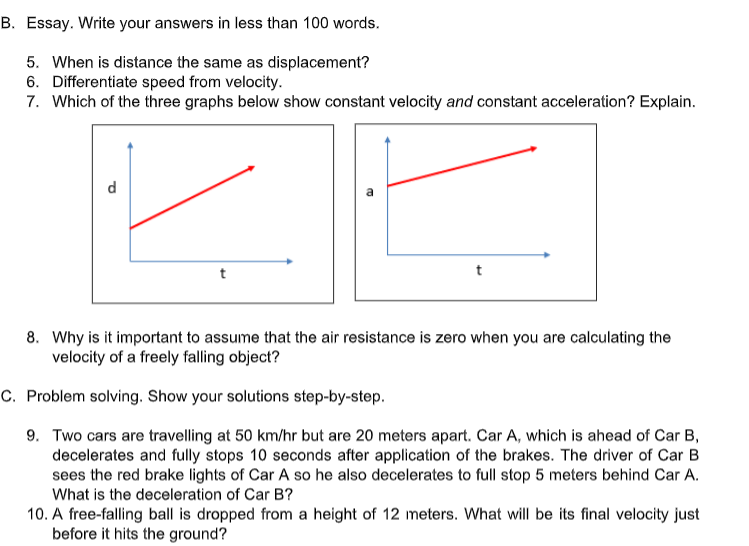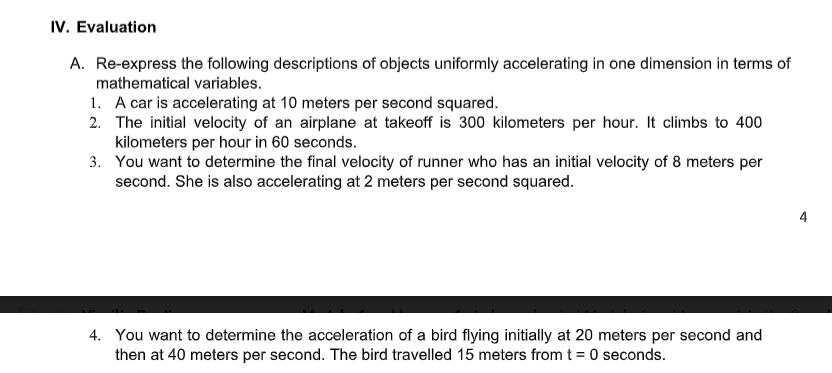A. Re-express the following descriptions of objects uniformly accelerating in one dimension in terms of mathematical variables. 1. A car is accelerating at 10 meters per second squared. 2. The initial velocity of an airplane at takeoff is 300 kilometers per hour. It climbs to 400 kilometers per hour in 60 seconds. 3. You want to determine the final velocity of runner who has an initial velocity of 8 meters per second. She is also accelerating at 2 meters per second squared.
A. Re-express the following descriptions of objects uniformly accelerating in one dimension in terms of mathematical variables. 1. A car is accelerating at 10 meters per second squared. 2. The initial velocity of an airplane at takeoff is 300 kilometers per hour. It climbs to 400 kilometers per hour in 60 seconds. 3. You want to determine the final velocity of runner who has an initial velocity of 8 meters per second. She is also accelerating at 2 meters per second squared.
College Physics
1st Edition
ISBN:9781938168000
Author:Paul Peter Urone, Roger Hinrichs
Publisher:Paul Peter Urone, Roger Hinrichs
Chapter1: Introduction: The Nature Of Science And Physics
Section: Chapter Questions
Problem 1PE: The speed limit on some interstate highways is roughly 100 km/h. (a) What is this in meters per...
Related questions
Question

Transcribed Image Text:B. Essay. Write your answers in less than 100 words.
5. When is distance the same as displacement?
6. Differentiate speed from velocity.
7. Which of the three graphs below show constant velocity and constant acceleration? Explain.
d
t
8. Why is it important to assume that the air resistance is zero when you are calculating the
velocity of a freely falling object?
C. Problem solving. Show your solutions step-by-step.
9. Two cars are travelling at 50 km/hr but are 20 meters apart. Car A, which is ahead of Car B,
decelerates and fully stops 10 seconds after application of the brakes. The driver of Car B
sees the red brake lights of Car A so he also decelerates to full stop 5 meters behind Car A.
What is the deceleration of Car B?
10. A free-falling ball is dropped from a height of 12 meters. What will be its final velocity just
before it hits the ground?

Transcribed Image Text:IV. Evaluation
A. Re-express the following descriptions of objects uniformly accelerating in one dimension in terms of
mathematical variables.
1. A car is accelerating at 10 meters per second squared.
2. The initial velocity of an airplane at takeoff is 300 kilometers per hour. It climbs to 400
kilometers per hour in 60 seconds.
3. You want to determine the final velocity of runner who has an initial velocity of 8 meters per
second. She is also accelerating at 2 meters per second squared.
4. You want to determine the acceleration of a bird flying initially at 20 meters per second and
then at 40 meters per second. The bird travelled 15 meters from t = 0 seconds.
Expert Solution
This question has been solved!
Explore an expertly crafted, step-by-step solution for a thorough understanding of key concepts.
Step by step
Solved in 2 steps

Recommended textbooks for you

College Physics
Physics
ISBN:
9781938168000
Author:
Paul Peter Urone, Roger Hinrichs
Publisher:
OpenStax College

College Physics
Physics
ISBN:
9781938168000
Author:
Paul Peter Urone, Roger Hinrichs
Publisher:
OpenStax College